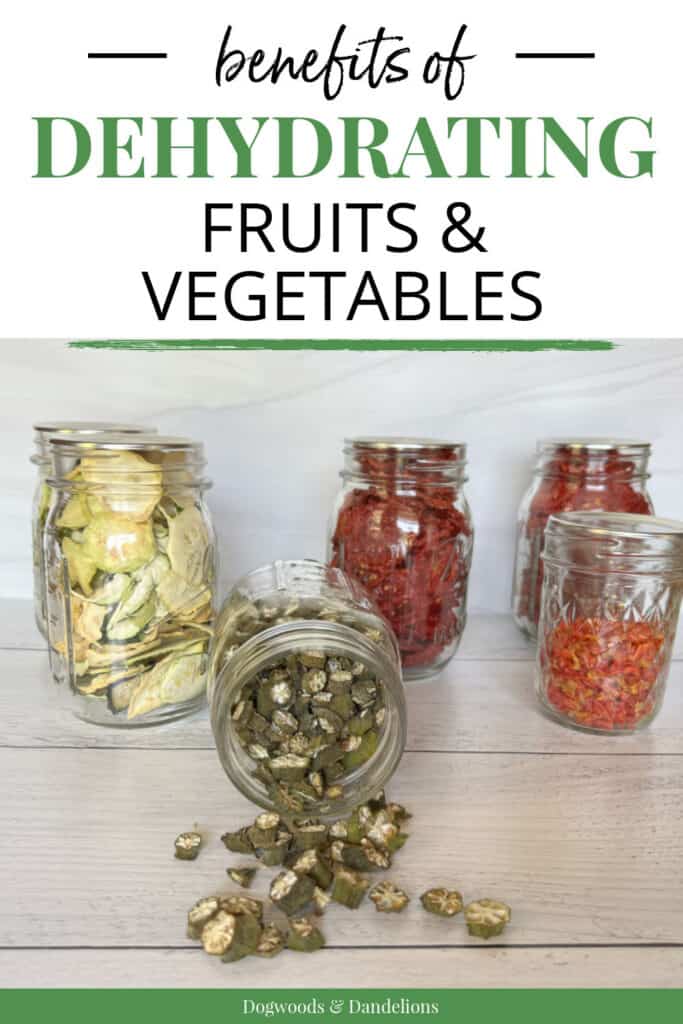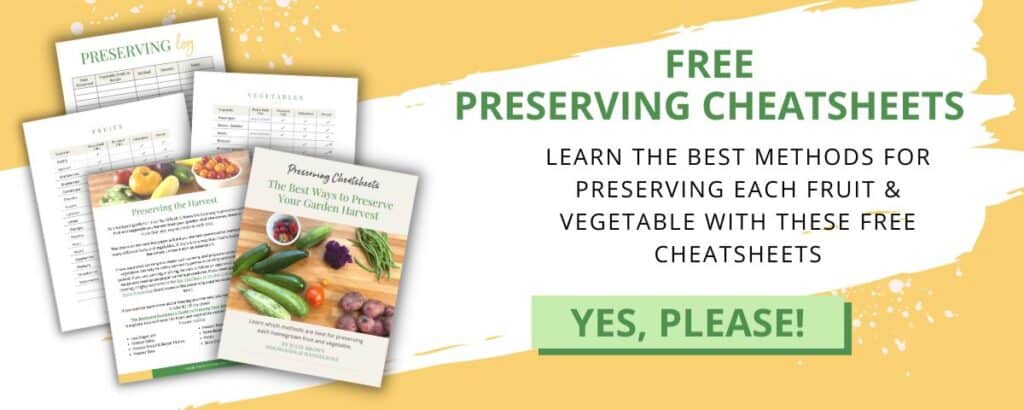Why Dehydrating is the Easiest Way to Preserve Vegetables & Fruits
Inside: For the backyard gardener, dehydrating vegetables and fruits can be the easiest way to preserve your harvest. Learn the benefits of dehydrating vegetables and fruits in this post.
My counters were covered in tomatoes. I hated to let all those precious food go to waste. I had sent some home with friends, but I still had oodles of tomatoes to deal with.
While my first choice of preserving tomatoes is freezing them, my freezers were bulging from green beans and peas that I had frozen.
I had made salsa. I had jars of tomato sauce lining my pantry shelves. Then I remembered my dehydrator tucked away in a closet. So I got that sucker out and got work.
And you know what? Dehydrating tomatoes turned out to be the easiest way to preserve them.
But what if you don’t have scads of tomatoes or cucumbers on every surface?
What if you just have one or two extra peppers?
Or maybe one too many squash? Dehydrating is still a great solution so they don’t go to waste.
Affiliate Disclosure: Please note that some of the links in this article may be affiliate links and I may receive a small commission if you purchase something through a link. It will not change your cost. As an Amazon Associate, I earn from qualifying purchases. For more information, see my disclosures page.)
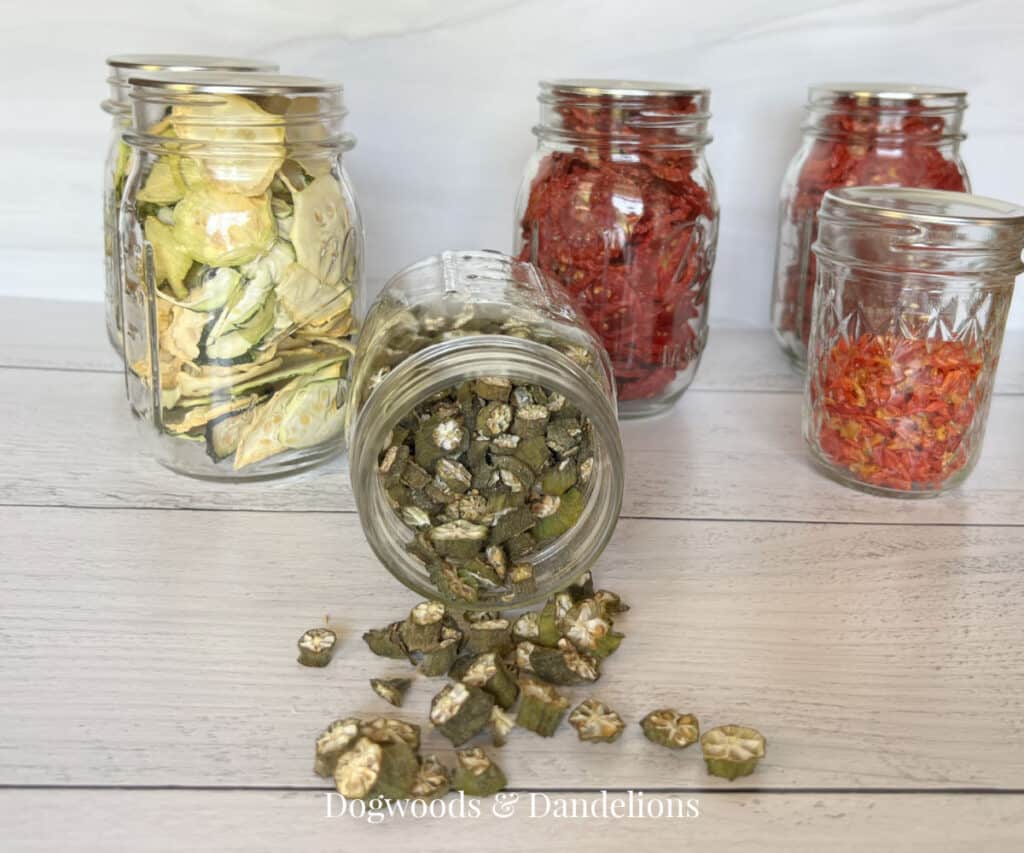
What Is Dehydrating?
The dehydration process is the process of removing water from food. Most dehydrators have a combination of a low temperature heating element and a fan that blows air across the trays of food.
Dehydrated fruits and vegetables retain more of their nutritional value during the drying process than canning does.
And if your food is sufficiently dry, it will not spoil because microorganisms and bacteria cannot grow in a dry environment.
While many people think of drying food as a novel idea, dehydrating is one of the oldest methods of food preservation.
Why Dehydrating is the Solution for Extra Vegetables (and Fruits)
When people think of preserving the harvest, they often think that means spending all day slaving over a hot stove listening to the pressure canner jiggle in the background.
But I’m going to tell you a different way. An easier way. A way that won’t take up all of your free time. And whether you have one extra tomato or 20, dehydrating will preserve those tomatoes for use all winter.
Dehydrating Takes Less Time
Canning tomatoes is my nemesis. I hate doing it. The counters end up sticky with drippy tomato juice everywhere.
But dehydrating tomatoes is a great way to preserve them and is actually quite simple. Slice your tomatoes (or just halve them if they are really small) and place them on dehydrator trays.
Set your dehydrator at 135 degrees and come back and check them 10-12 hours later. So easy.
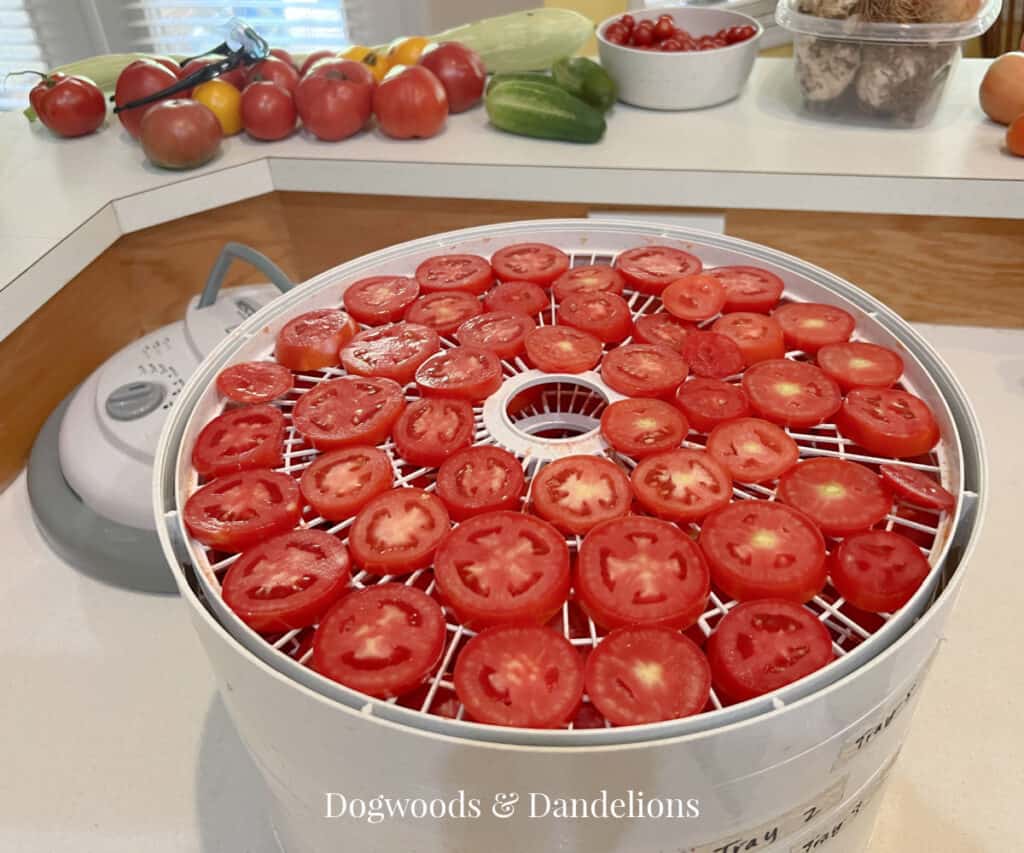
Dehydrating Doesn’t Heat Up Your House
When it’s hot outside, the last thing I want to do is stand over a hot stove to preserve my garden bounty. And that hot stove will also heat up your house.
Unless you have the luxury of an outdoor kitchen or a propane burner, you don’t have much choice but to can indoors. And even if you have one of those, you’re still going to be hot while you can your vegetables and fruits.
Dehydrating your fresh fruit and vegetables can easily be done in the cool of your house. And the dehydrator doesn’t make your house nearly as hot as the stove would.
Dehydrated Food Is Shelf Stable
I love the fact that my dehydrated food is shelf stable. Once my food has been dehydrated, I’m not using electricity to store it like you would if you are freezing something.
We often have power outages in our area, and frozen food will only last a day or two in a tightly sealed freezer before it starts to thaw.
Properly dehydrated food can sit on your pantry shelf for years. It is considered to have a longer shelf life than canned or frozen food.
And dry foods are easy to use. If you have a way to boil water, you can rehydrate your food, even if the power is out.
Dehydrated Food Takes Up Less Space
I also love how little storage space dehydrated food takes on my pantry shelves. For instance, a gallon bag of tomatoes takes up quite a bit of room in my freezer. I can get a gallon bag of tomatoes into a pint jar with room to spare once they are dehydrated.
Dehydrated Food is Lightweight
Dehydrated food weighs so much less than canned food. Even if you aren’t a hiker or a prepper, it is nice not to have to worry about the weight of your dry food breaking your shelves like you might with canned food.
Dehydrating Doesn’t Take a Lot of Supplies
A final reason to love dehydrating food is that you really don’t need a lot of supplies. Yes, you will have the best results if you purchase an electric dehydrator, but they can be found fairly inexpensively nowadays.
The only other tools you need are probably already in your kitchen. A knife, a cutting board, and a few mason jars for storage are all you really need to get started dehydrating food.
How to Choose a Dehydrator
Choosing a dehydrator can be a difficult decision. But for the best-finished product, electric dehydrators are the way to go. And there are many different kinds of electric dehydrators on the market at a wide range of prices.
If you are just starting out dehydrating food, I probably wouldn’t spend the money for the top-of-the-line model. A low to mid-priced dehydrator will serve you well until you see how much you will use it.
I would be sure you can adjust the temperature since you need lower temperatures for herbs than for vegetables.
My favorite (and the one I’ve used for over 10 years) is a Nesco Snackmaster. I like that I can add or remove trays as necessary depending on the amount of food I am dehydrating.
However, I recently spotted this new Nesco square dehydrator similar to more expensive ones on the market. This comes in a 4-tray or 7-tray model and I’ve got to say, it is super cute. And while I haven’t tried it myself, the reviews look promising.
Nesco also makes a more budget-friendly choice if you know you won’t be preserving lots of food at once.
If you have lots of food to preserve, the Excalibur dehydrator is usually thought to be the top-of-the-line dehydrator. There are several models to choose from with varying numbers of trays.
However, I have been very happy with my Nesco and if something happened to mine, I would probably just purchase the same one again. However, the model has changed slightly since I bought mine.
I also want to mention that in years past Aldi has had dehydrators for sale around July/August. If you have an Aldi in your area, it might be worth checking out.
The biggest downside to owning a dehydrator is finding somewhere to store it. However, mine doesn’t take up much more room than a canner would and it’s so much easier to use.
Can You Dehydrate Fruits & Vegetables In the Oven?
Another option for dehydrating fresh vegetables and fruits is your oven, if it will go low enough. You can probably successfully dehydrate fruits and vegetables in your oven if it will go down to 150 degrees.
If not, I don’t recommend trying oven drying. If you do use your oven, you will need to slightly prop open the oven door so moisture can escape. This is definitely not a good option if you have small children in the house.
And if you do much dehydrating in the oven, you will likely spend more on electricity (if you have an electric stove) than purchasing your own food dehydrator would cost.
Other Options to Consider
If you have a toaster oven or an air fryer, you might want to check and see if it has a dehydrating function. I recently purchased this Ninja Foodi Countertop Oven on a huge Prime Day sale and I realized it has a way to dehydrate. (This is a cheaper model that also has the dehydrator function.)
I haven’t tried it out yet, but it would be a great way to preserve small amounts of fruits or vegetables.
You can also make or buy a solar dehydrator. Usually, solar dehydrators work best in hot, dry climates. But while North Carolina has plenty of hot weather in the summer, it is usually way too humid to try drying fruits and vegetables outdoors.
How to Dehydrate Vegetables and Fruits
While I can’t cover every fruit and vegetable in this post, I’m going to share the basics of dehydrating your garden crops. Dehydrating is also a great option for those fruits and vegetables that are on sale at the grocery store.
Most fruits and vegetables should be dehydrated at 135 degrees. Herbs should be dehydrated at 95 degrees.
First, wash your produce. Slice, dice, or shred your produce into uniform pieces. If you have a lot of food to chop a food processor will make the job much easier. Many fresh fruits benefit from a quick dip in a mixture of cold water and either citric acid or lemon juice.
Place the pieces on your dehydrator trays in a single layer and dehydrate them at the correct temperature.
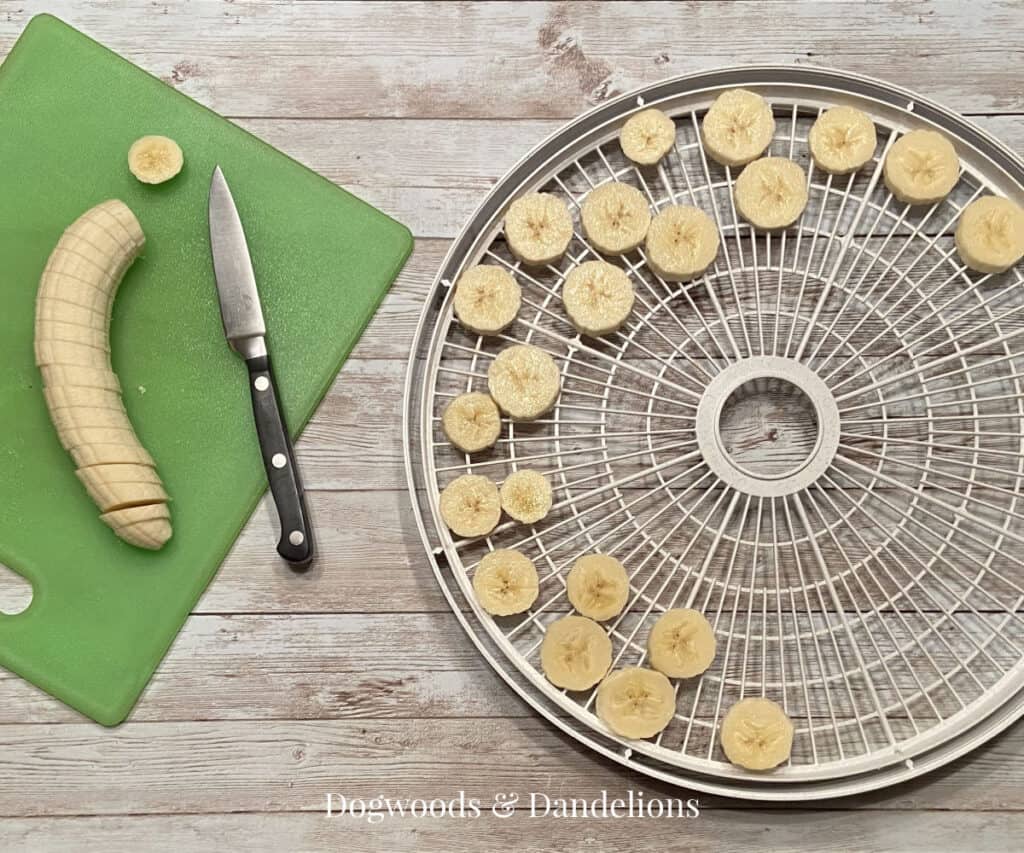
Check regularly to see when the produce is dry. There should be no visible moisture on the outside and if you cut into a piece of food it should be dry inside as well.
If you are unsure if your food is dry, it is better to overdry it than leave it too moist. Food that isn’t properly dehydrated will likely mold. And one moldy piece of food in your storage vessel means that all the food in the container must be thrown out.
Depending on the size of the food pieces and your dehydrator model it can take anywhere from several hours to a day or so for your fruits and vegetables to dry.
These posts explain how to specifically dehydrate these individual vegetables:
- How to Dehydrate Cucumbers
- Dehydrating Tomato Sauce
- How to Dehydrate Bell Peppers
- Dehydrating Zucchini Noodles
How to Store Dehydrated Food
The easiest way to store your dried produce is in mason jars or other airtight containers in a dry place out of direct sunlight. If you have a vacuum sealer, (I have this brand.) you can purchase a jar attachment that will suck the air out of mason jars.
I love this little trick because I can put up my vegetables in smaller jars and open them one at a time so they don’t go soft too quickly.
In doing research for this post, I came across this little vacuum sealer specifically for mason jars. I have not tried it, but it might be a good option for someone who only wants to store dehydrated food in jars. It is much less expensive than a vacuum sealer that uses bags.
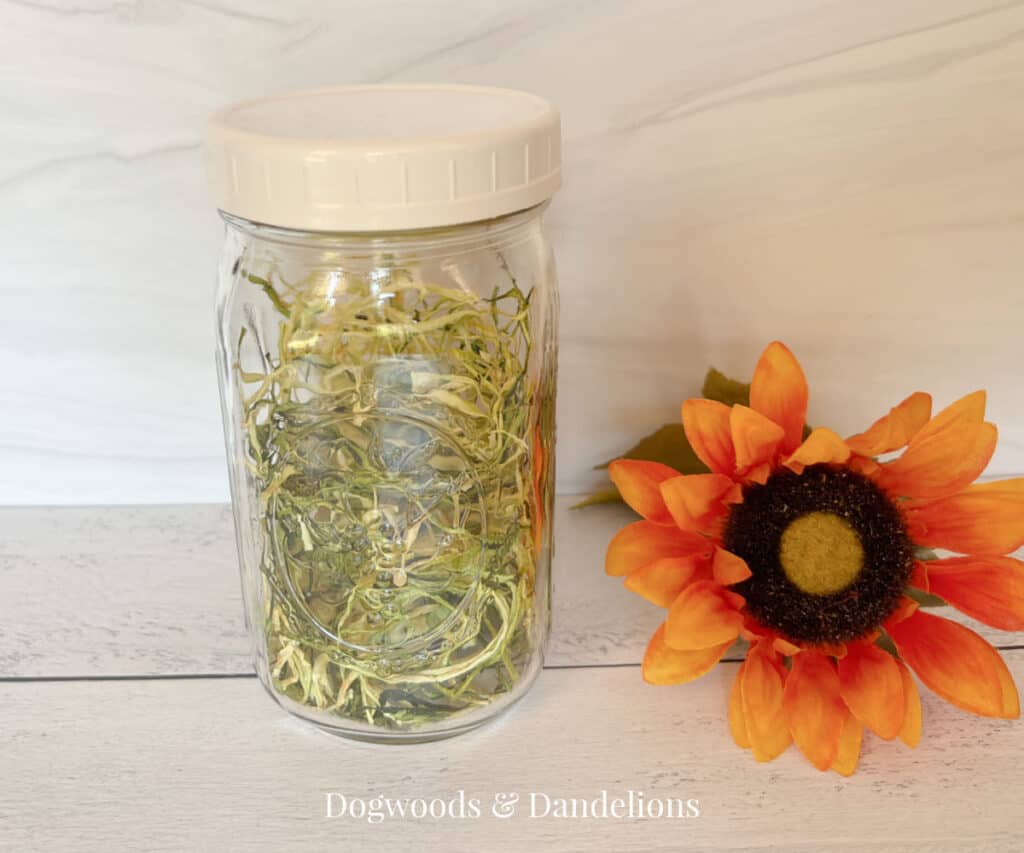
Vacuum-sealing in bags is another possible option for some vegetables but it tends to crush really crispy ones.
Once you have your produce sealed, store your jars or bags in a cool dark place away from excess moisture.
If you want to store your dehydrated produce for longer than a year, adding an oxygen absorber to the jar or vacuum-sealed bag is a good idea to remove any residual oxygen.
I have tried storing dried food in a Ziplock bag but it doesn’t seem to stay crisp very long. Over time it will reabsorb a bit of moisture and sometimes even get sticky.
I personally like storing fruits and vegetables in vacuum-sealed mason jars. The jars look so pretty on my pantry shelf with the various colors of dried food in them. It makes me smile every time I see them.
How to Use Dehydrated Vegetables & Fruits
Some people are intimidated by the thought of using dehydrated food. But it’s not difficult at all. If this is your first time using dried food, I recommend making a soup with some of your dehydrated vegetables.
You can add your veggies directly to the broth, bring the mixture to a boil, and simmer for about 15 minutes. You may need to add additional broth as the vegetables will absorb quite a bit of liquid.
To rehydrate vegetables to use in other recipes, pour boiling water over the vegetables and allow them to stand for 15 minutes or so until the food is rehydrated.
If you are rehydrating fruits, it is usually best to pour cool water over them and allow them to sit in the refrigerator overnight.
Other Uses for Your Dehydrator
You can also use your dehydrator to make fruit leathers for healthy snacks, green powders to add to smoothies, dried fruit for trail mixes, and shelf-stable soup mixes.
You can also powder various vegetables to make a broth powder to reconstitute if you don’t have beef or chicken broth on hand.
I’m on a mission to make the process of food dehydrating more mainstream. It is one of the best ways to “put up” your own produce from your backyard garden.
Food dehydration is also one of the safest food preservation methods and it has so many benefits. Turning fresh food items into food with a long shelf life is the best way to preserve your favorite foods. You can reduce food waste in your own household and save money too!
Having your own dehydrated food on your shelf can also give you a sense of security in these uncertain times. I hope you’ll give the benefits of the dehydrating process some thought and consider making this one of your food preservation methods in the future.

Meet Julie
I’m a farm girl born and bred in North Carolina. I’ve been growing a vegetable garden for over 20 years (and helping my Mom grow hers even longer). I’ve been raising chickens in my bathtub and backyard for 12+ years. I believe that homegrown food can be made simple. Let’s get started.
